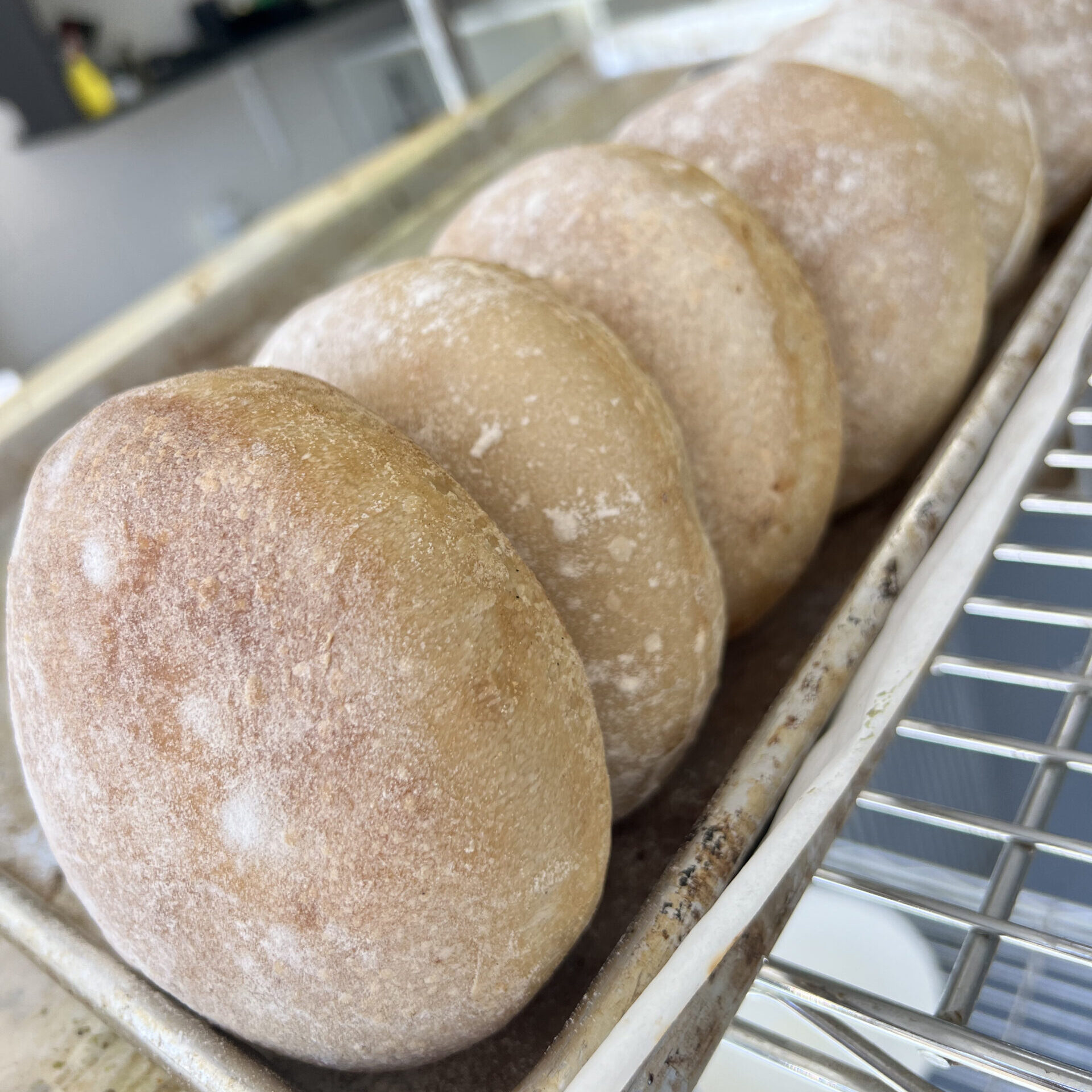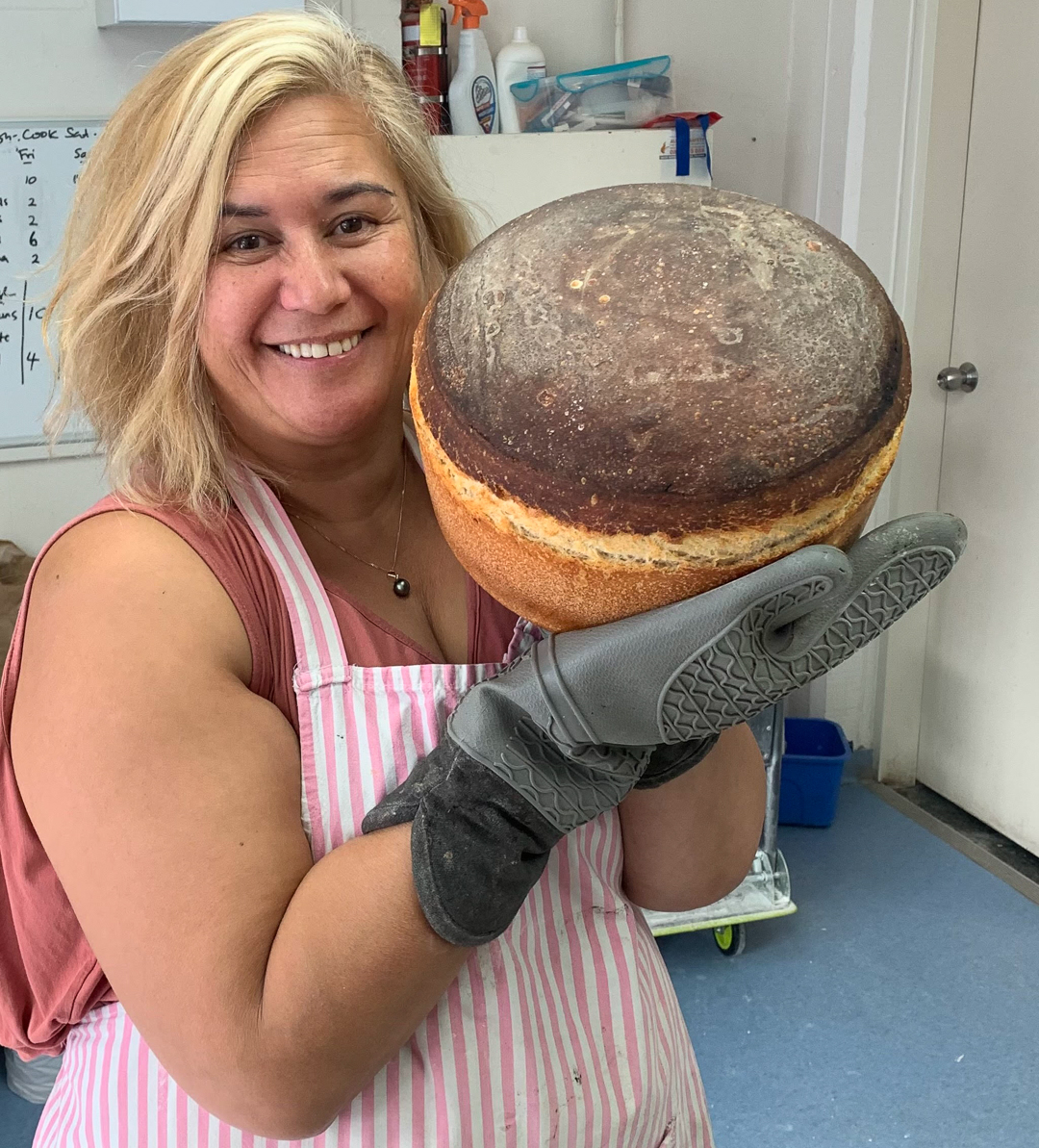For the love of rewena bread
Besides being delicious to eat, rēwena bread is a traditional Māori kai that has a rich history steeped in whakapapa. In a recent kōrero with Keri-Mei Zagrobelna from Garland Magazine, Lynda shares her personal relationship with rēwena, and why this kai holds a special pat of her heart.
April 9, 2023
If I could describe what family and warmth would smell like, it would be the scent of a freshly baked loaf of rēwena bread straight from a hot oven. It is the smell of fond memories wafting through a busy household, words from kind aunties, and a sense of safety, love, and well-being. These are just some of the senses invoked by rēwena bread.
Throughout many cultures, bread has been a key player in the crafting and participation of ritual and culture. It can be seen everywhere: the holy communion bread at a Sunday sermon, the Jewish challah bread served only on major Jewish holidays, or the baked loaves to honour the ancient pagan grain Gods at Lammas. As a jeweller, I found it interesting that Lammas is also a day of honouring Lugh, the Celtic craftsman God.
Rēwena bread, also known as Māori bread, is a type of sourdough that is unique to Aotearoa (New Zealand). It is a Māori food that symbolises status, wealth, nourishment, and genealogy. Therefore, this makes rēwena bread more than just a bread, it is an intrinsic part of a culture where the nourishment of your body and soul are centred around whānau (family) and whakapapa (genealogy). Served on special occasions, each whānau has its own rēwena bread maker superstars and recipes.

My first memories of rēwena bread are of sitting with my Nan and watching as she baked these precious loaves of goodness for occasions, either at home, or at the marae. I remember the aunties wearing long black skirts carrying dutch ovens covered with chequered tea towels in the throws of the kitchen hearth.
I know many others who also share similar memories associated with rēwena bread. Why do we feel so connected with this food? It is simply more than just something tasty and delicious to eat. It also features in rituals of memory, sensations, and wairua (energy). It is kneaded in the process. It is feeling like you are part of something larger and greater than yourself.
As a maker and an artist, I needed to know more about this craft and dive deeper into the subject. I wanted to know how it felt for the baker craftsman. Seeking and reaching out to my own family as a way to start this journey of discovery, I make a visit to my Aunt’s bakery “Little Bread Loaf”, a hole-in-the-wall bakery born out of passion and a desire to share culture and food.
As I glance across the counter of breads, pretzels and treats sprinkled with hand-picked candied blossoms and cinnamon, there are framed photos of family. The expresso machine whizzes, as she makes us a cup of coffee and I look up at that top shelf filled with trinkets and delicate fine china tea cups. There are photos of her mother, father and children and they all smile back at me. There is joy felt here at this wee bakery sanctuary, outside there is the sound of my cousins laughing and playing, it echos out across the carpark and back into my heart. My uncle, my other aunt and several of my cousins aged 3 to 17 were all here when I arrived. It seems that this is the place to gather on a Sunday, perhaps this is our special wee family church and the start of a new tradition. We hand out bakery treats left over from this morning’s market stall to the whanau and drink coffee while catching up over breaking bread.

My Aunty Lynda tells me that one day she was sitting in her kitchen and it came to her that the only other member of the whānau that still makes the traditional rēwena bread is our Aunty Com. This instilled a feeling of fear in Lynda, who noted, that with many of our elders passing away, this traditional practice and art form like so many others are at risk of being forgotten or lost and something needed to be done to maintain and uphold this cultural practice.
Sitting, I listen eagerly like I am a small child again and ask my Aunt what she believes defines good rēwena bread. Her answer is simple, it is made with a traditional rēwena bug with no introduced yeast. It is active and has a certain “scent” to it, similar to a tinge of ammonia. A traditional bug is made with potato water or grated potatoes, water, flour, and sugar. The best part of this bread bug is in its simplicity, making it accessible for families to be able to engage with their culture and these Māori traditions.
Lynda felt it was important to make things accessible in a post-pandemic time when families may be struggling financially. Coming from her own direct experience of struggle, Lynda grew her own veggies, made her own chutneys, and baked her own bread. Helping not only ease some of these stresses, but also as a pathway connecting her to her own culture on a tactile, practical, and healing level. This is what she wanted to teach and share.
Many traditional Māori cuisines have come from a similar place. The traditional Māori boilup, or cooked fish heads, are demonstrations of innovation using cost-efficient ingredients to create meals that can feed many. As Māori, food is a means in which to demonstrate our wealth, it is manaaki ( hospitality). In our manaaki, our mana (strength/reputation) can be measured. You may be wealthy, but if you don’t have enough food or kai for your guests your mana can be questioned. Gifting a loaf of rēwena bread can be a powerful thing. Being the bread maker in a family can be considered a high-status role.
The starter used for the bread bugs can be kept for years and many families will have their own bugs that have been passed down through the generations. The fermentation of a starter takes about a week and is about patience and care. My thoughts muse on my own carving practice and how it holds the same principles of patience, care and time. What I craft also speaks to the stories of our ancestors. In a mātauranga Māori world view, everything is interconnected, even bread and taonga.
We discuss how the rēwena bug is a holder and vessel of genealogy and that traditions are passed down through this living organism. A simple starter bug becomes a strong pou (post) or standing stone for families to hold on to the knowledge and share this with future generations. The starter bug is a being, if he is happy and fed well and in the right conditions then he will provide for everybody.
Lynda has named her rewena bug “Pari Pari”. It is a gifted name from her iwi Whanau-ā-Āpanui who are from the East Coast of New Zealand. She describes how you feed the bug and when the bug isn’t being used, it goes to sleep. The bug becomes a part of the family, it needs feeding, nourishment, love and it is a manifestation of our whakapapa.
She feeds Pari Pari in a quiet space—it’s a personal relationship—after everyone goes to bed or early in the morning. Sometimes she turns the lights off. For Lynda, it is a spiritual trance-like journey, taking her to another space and time.
Another passionate baker and craftsman of the traditional Māori sourdough is George Jackson who resides in the Whanganui region. Jackson’s rēwena bread and starter bug is to be included in the UNESCO Global Breads of the Creative Cities project to document and promote bread-making traditions and cultures. UNESCO describes bakers, millers, and farmers as knowledge keepers, saying bread plays a culturally significant role in the heritage of a community and is a symbol of sharing and giving.
I ask my Aunty what it’s like making the bread. She tells me, “You need to feel the dough”, it is like reciting your pepeha, people that have been a part of your history are a part of your present when making bread.
“When you’re talking about or reciting your pepeha, you are remembering it is likened to the process and ritual with rēwena because the memories invoked through this. You are imparting your whakapapa into the bread.
“You know when a good dough is a good dough cause you can see it and feel it. It takes in your whole senses. Good dough will be smooth and silky, wet but not overly wet, and has an elastic quality”.
Much like other forms of crafts, years of testing and trialling are done to know how much kneading is required. The rēwena bread’s lift and form are purely based on the health of the starter. If it has a healthy starter, it will rise and give that lovely rounded shape associated with rēwena bread
Lynda tells me that at times it feels as if her hands are being guided by other people when she is kneading her bread. I relate instantly to this having experienced in my own creative practice an otherworldly presence guiding my hands with the chisel and saw blade, or when selecting materials.
My tummy grumbles and it is time to bite into this delectable morsel of rēwena bread sitting in front of me. I close my eyes and lift the bread to my nose and smell an inviting yeasty delight. It’s as if I can already taste it and my mouth starts to water. It has a strong scent with sour notes from Pari Pari. I hold the bread as if it’s the most precious thing in the world: it feels warm and inviting. It has a honey-coloured golden crust and slicing through it seems dense but it isn’t heavy. As I bite in, my taste buds light up to the slight tangy notes within the fibres. It hits the roof of my mouth first before enveloping me in memories of comfort.
I open my eyes and look at my Aunty, she smiles at me and says “People are going to feel everything that you have placed into the bread, every ounce of love,” and right now in this present moment this is what I feel. I feel safe and I feel I am home.
